Improve Your Posture and Mobility with Simple Self-Tests and Exercises
If you’re trying to fix your posture and mobility, the internet can be confusing. There are so many opinions and solutions. It’s hard to know where to start.
The truth is, there’s no one-size-fits-all approach. You need to address your individual needs.
In this blog, you’ll learn a self-testing framework to pinpoint your specific mobility restrictions. These are the same tests and exercises I use with my clients to improve their mobility.
Table of Contents
Understanding Posture and Mobility
A wise man, Obi-Wan Kenobi, once said, “Your eyes can deceive you, don’t trust them.” This applies to posture too.
To know the best posture improving strategy for you, you must know what you’re dealing with. You need to test to see where your restrictions lie.
Self-Testing Framework
Here are five tests to help you identify your mobility restrictions:
- Seated Trunk Rotation
- This test checks your overall rotational mobility.
- Sit with the back of your hands on your face and arms on your chest.
- Rotate your trunk and head as one unit.
- If you can’t reach 45 degrees, muscles in your trunk and pelvis are tight.
- Toe Touch
- This test checks your internal rotation and lower part of the pelvis
- Stand with your feet hip width apart with knees straight.
- Bend forward and try to touch your toes.
- Squat
- This test checks the upper part of your pelvis and lower back.
- Stand with your feet pointing forward.
- Squat down as low as you can, keeping your feet flat.
- If your feet spin out or heels lift, call the test
- Shoulder External Rotation
- This test checks the mobility in your upper back and lower ribs.
- Lie on your back with knees bent and arms at a 90-degree angle.
- Rotate your arm back.
- If your knuckles can’t rest on the ground, improve mobility in your rib cage.
- Apley’s Scratch Test
- This test checks internal rotation.
- Reach both arms behind you.
- One arm touches the top of the opposite shoulder blade.
- The other arm touches the bottom of the opposite shoulder blade
- If you can’t, you are restricted in internal rotation.
Categorizing your restrictions
We will NOT look at these tests in isolation. We want to look at them as a cluster to determine what areas we must create more motion.
While there are several possibilities, we can break limitations down broadly into the following categories:
- Limited Overall Rotation – Decreased seated trunk rotation
- Limited External Rotation – Decreased squat and shoulder external rotation
- Limited Internal Rotation – Decreased toe touch and apley’s scratch test
Now let’s look at what exercises will tackle each problem:
Exercises to Improve Mobility
What you want to do is figure out which category you fit, try the moves for 2-4 weeks, and recheck your measures to see if you need to progress to the next level or work on harder variations within the same category.
Here’s what to do for each bucket:
Limited overall rotation
The primary goal here is to reduce overall muscle tension.
- Yoga Block Decompression
- Lie on a yoga block under your lower ribs and pelvis.
- Relax and breathe deeply for 4-6 counts.
- Do three sets of 60 seconds per side.
- Side-Lying Foam Roller Roll
- Lie on your side with your leg or arm resting on a foam roller.
- Move forward and backward slowly with minimal tension.
- Breathe quietly and repeat for two to three minutes per side.
- Side-Lying Arm Bar
- Lie on your side with a light weight in your top hand.
- Bottom arm presses into ground
- Top leg bent. Bottom leg straight
- Hold and breathe in this position for 30-60 seconds
- To up difficulty, you can roll to your back during the inhale. And back to the start during the exhale.
- Hold the weight and roll from side to back and back to side.
- Repeat two to three sets of 10 rolls per side.
To progress from these, the side hang is absolutely MONEY
- Straddle a glute ham raise or bench
- Hang over the side with arms crossed
- Breathe slowly in position
- Work up to 3-4×30-90s holds
Limited External Rotation
The goal here is to open up space in the upper pelvis and back regions.
- Wall Squat
- Stand 1.5-2 feet from a wall with your feet flat.
- Squat down slightly and hold your arms up.
- Hold for three sets of 45-60 seconds.
- Low Oblique Sit
- Lie on your side with your bottom hip at 60 degrees.
- Top foot is in front of bottom ankle
- Roll forward so bottom knee and wrist touch the ground
- Use these points to push your trunk up
- Breathe slowly
- Hold for three sets of 30-60 seconds per side.
- Supine frog breathing
- Lie on your back with feet together and knees apart
- Waistband should be on the ground. If not, straighten the knees
- Arms – either mirror the legs (if limited in shoulder external rotation) or reach up at 110º shoulder flexion with palms up (if limited in shoulder internal rotation)
- Breathe slowly
- Hold for 3 sets of 30-60 seconds per side.
To progress the difficulty, move to this knee push split squat variation:
- Foam roller split squat
- Eyes forward
- Foam roller between outer knee and wall
- Drop down into a split squat
- Feet stay flat, press knee into foam roller
- Breathe slowly
- Hold for 3 sets of 30-60 seconds per side.
Limited internal Rotation
If you are stuck here, we are going to focus on opening up the bottom part of the pelvis and trunk.
- Box Squat
- Stand on a box with soft knees and a weight in your hands.
- Sit down on the box and come back up without locking your knees.
- Do two to three sets of 10 reps.
- Frog breathing
- Feet together, knees apart
- Hands together, elbows apart
- Face down, with hips at 70º flexion.
- Start sagged
- Exhale and press trunk upward halfway, using pisiform on wrist, elbow, and knees
- Breathe slowly
- Hold for 3 sets of 30-60 seconds per side.
- Elevated Split Squat
- Place one leg on a box and the other leg back.
- Drop down slightly and hold. Stay heavy on the front leg
- Hold for three sets of 30-60 seconds per leg.
And if you really want to get nuts, progress to a bottoms-up version of the movement:
- Bottoms-up Split Squat hold
- Start in half kneeling with a support
- Barely come off the ground, staying heavy on the front leg
- Hold for three sets of 30-60 seconds per leg.
Sum Up
By following these self-tests and exercises, you can improve your posture and mobility. Remember, there’s no one-size-fits-all solution. Use this framework to address your specific needs. Good luck, and keep moving!

